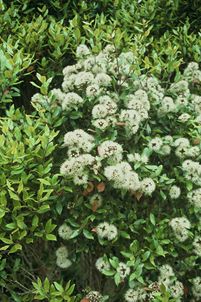And the winner is…2014 New Zealand Favourite Plant Vote concludes
 Metrosideros bartlettii in bloom, Te Paki (Photo: Peter de Lange)
Metrosideros bartlettii in bloom, Te Paki (Photo: Peter de Lange)
2014 Favourite Native Plant
The 2014 Favourite Plant and Worst Weed election has come to an end. Voting for your favourite New Zealand plant and worst weed was run through November. This the 12th annual competition for favourite plant was contested fiercely in the early stages between an orchid, a colorful legume, a rare rata, and a commonly known southern tree. Toward the end of the vote the favourite was clear, deservedly earning 32% of the vote.
The winner of the 2014 Favourite Plant as voted by you is . . .
Rata moehau / Bartlett's rata epitomises a species in trouble; which is why the NZPCN was formed. This iconic and taonga rata species of the far north (Te Paki) is known from only three widely separated populations. At up to 30 metres high this fantastic species is a dramatic site to see in bloom with its beautiful white flowers instead of the more commonly known red flowers of the pohutukawa and rata. This seriously threatened tree is in serious decline, with only 25 known individuals left in the wild down from 32 in the early 1990’s (and with most of those 25 in ill thrift or dying), this fact makes it more rare than the Kakapo. A favourite diet to the pestilent possum, many of the remaining specimens are found on private land without possum control making them very susceptible to attack. The small number of individuals, growing in three extremely isolated sites and the virtual lack of effective pollination vectors means very little if any outcrossed seed is set, affecting recruitment through inbreeding depression. Past research indicates that there is very little genetic variation left in this species anyway, and alarmingly most of that occurs in the largest population, which is on private land with complex legal access issues. The lack of genetic variation in the wild is compounded by the apparent lack of genetic diversity in cultivated material - most of which is supected to come from a single tree. The sad story of this species really depicts how much it needs our help, so we are very happy it has been recognised as the 2014 Favourite Plant.
Some of the fantastic and knowledgeable comments made by voters include:
Gillian said, “I first got to know this tree in 1991 and then spent several weeks being eaten alive by mossies searching for more in 1992. Its such a neat tree, so special and its so sad its going under.”
Brian said. “It's a spectacular tree and a taonga to local iwi”
Martin said, “Rata Moehau is magnificent - it exudes mana.”
Shelly said, “Any botanist worth their salt should take a pilgrimage to Te Paki to see this spectacular tree.”
Dave said, “An amazing tree indeed. I have worked under its canopy at Radar Bush - a wonderful forest, wonderful place and amazing flora.”
Fran said, “Vote for your 'Favourite Plant' to me is about raising profiles, and if it can help aid a plants conservation by drawing it to the media's eye even better - this tree is threatened by possums and myrtle rust (when it gets to NZ) - its known from less than 25 surviving wild trees and very little genetic diversity is in cultivation. It needs help so it gets my vote.”
Pieter said, “Its a special tree - so uncommon, amazing flowers, a flagship species for Te Paki forests.”
Debby said, “Iconic, massive, spectacular.”
Top ten species for the 2014 Favourite Native Plant vote
- Bartletts rata - Metrosideros bartlettii (30%)
- Kauri Greenhood - Pterostylis brumalis (19%)
- Dobson’s speargrass - Aciphylla dobsonii (12.5%)
- Kakabeak - Clianthus puniceus (7%)
- Kamahi - Weinmannia racemosa (5%)
- Copper beard orchid - Calochilus herbaceus (4.6%)
- NZ Gloxinia – Rhabdothamnus solandri (3.3%)
- Wiggywig – Muehlenbeckia astonii (2.1%()
- Wood rose – Dactylanthus taylorii (2%)
- Dracophylum townsonii (1.6%)
You can see the full results here